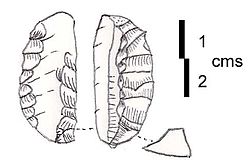- Orange slice
-
Orange slice is an early sickle blade element made out of flint.[1] The flints are so called due to their shape, which resembles a segment of an Orange. This sickle industry has no evidence of developed denticulation.[2] Orange slices were used for harvesting plants at the start of the Neolithic revolution and were particularly prevalent in Lebanon where they were found alongside Gigantolithic choppers of the Qaraoun culture in and around Qaraoun in the south of the country. Sites where orange slices have been found include Majdel Anjar I, Dakwe I and II, Habarjer III, Qaraoun I and II, Kefraya, and Beı'dar Chamou't.[3]
References
- ^ Moore, A.M.T. (1978). The Neolithic of the Levant. Oxford University, Unpublished Ph.D. Thesis. pp. 443. http://ancientneareast.tripod.com/183.html.
- ^ Lorraine Copeland; P. Wescombe (1965). Inventory of Stone-Age sites in Lebanon, p. 145. Imprimerie Catholique. http://books.google.com/books?id=6YsRRwAACAAJ. Retrieved 21 July 2011.
- ^ L. Hajar, M. Haı¨dar-Boustani, C. Khater, R. Cheddadi., Environmental changes in Lebanon during the Holocene: Man vs. climate impacts, Journal of Arid Environments xxx, 1–10, 2009.
Categories:- Tools
- Lithics
Wikimedia Foundation. 2010.

